

Consumer-Driven Contracts: A Retrospective. Lightweight SOAs: Exploring Patterns and Principles of a New Generation ... Enterprise Applications Management. The Next Revolution in Productivity. The Idea in Brief Despite decades of reengineering, large companies still have problems with their business operations.
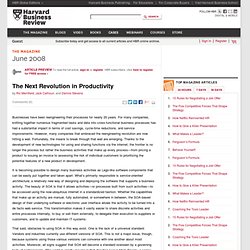
They duplicate processes. They perform hundreds of noncore tasks that should be outsourced. And they spend vast sums on proprietary process-management software that’s difficult to update. To combat these inefficiencies, use service-oriented architecture (SOA)—a new way of designing the technology that supports your business processes. But to win these payoffs, you must transform your company from a collection of proprietary operations into a collection of “plug-and-play” activities. Merrifield, Calhoun, and Stevens recommend a method for effecting this transformation. Pioneer plug-and-play processes in your organization, and you’ll help fuel the next great leap in corporate productivity. The Idea in Practice The authors suggest this process for determining which aspects of your business operations will best benefit from SOA technology. 1. 2. The Next Revolution in Productivity.
SOA Challenges: Entity Aggregation. Ramkumar Kothandaraman Microsoft Corporation May 2004 Applies to: Microsoft® Visual Studio® .NET Summary: Use Entity Aggregation (EA), within the larger content of a Service Oriented Architecture (SOA), to integrate duplicate information present in different services in your enterprise that are autonomous in nature—HR, Payroll, and Benefits, for example. (20 printed pages) Contents AbstractIntroductionEntity AggregationEntity Aggregation ServiceDesign IssuesPlatform SupportConclusion Abstract Service Oriented Architecture (SOA) is gaining widespread acceptance in the IT industry.
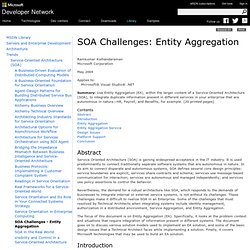
Nevertheless, the demand for a robust architecture like SOA, which responds to the demands of businesses to integrate internal or external service systems, is not without its challenges. The focus of this document is on Entity Aggregation (EA). Introduction As businesses continued to expand over the years, their demand for more IT systems increased. The rest of the paper discusses Entity Aggregation. Audience Notation. Autonomous Services and Enterprise Entity Aggregation. Real World SOA Experiences. Chris Haddad from Burtonwrites about their recent research in determining the success of SOA deployments in the real world: [we are] currently conducting formal research to get a detailed and updated perspective of SOA adoption.
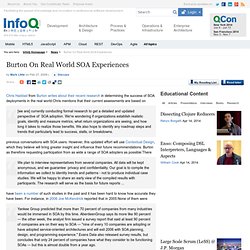
We're wondering if organizations establish realistic goals, identify and measure metrics, what return organizations are seeing, and how long it takes to realize those benefits. We also hope to identify any roadmap steps and trends that particularly lead to success, stalls, or breakdowns. Chris mentions that their current assessments are based on previous conversations with SOA users.
However, this updated effort will use Contextual Design, which they believe will bring greater insight and influence their future recommendations. We plan to interview representatives from several companies. There have been a number of such studies in the past and it has been hard to know how accurate they have been. Your SOA is JABOWS (Just A Bunch Of Web Services) and I can prove it.
Are you ready to answer this challenge... can you prove that your Service Oriented Architecture (SOA) is NOT JABOWS?
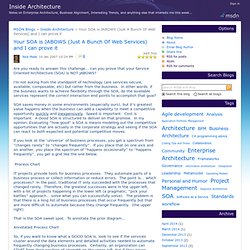
I'm not asking from the standpoint of technology (are services secure, available, composable, etc) but rather from the business. In other words, if the business wants to achieve flexibility through the SOA, do the available services represent the correct interaction end points to accomplish that goal? SOA saves money in some environments (especially ours), but it’s greatest value happens when the business can add a capability to meet a competitive opportunity quickly and inexpensively. Speed is important. Cost is important. If you look at the ‘universe’ of business processes, you get a spectrum from “changes rarely” to “changes frequently”. IT projects provide tools for business processes. That is the SOA sweet spot. So, to evaluate how good a SOA is, you need to ask: A. JaBoWS, JBoGS and PoPS are just Stepping Stones. Jeff Schneider writes about the evolution of SOA initiatives.
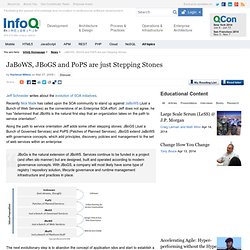
Recently Nick Malik has called upon the SOA community to stand up against JaBoWS (Just a Bunch of Web Services) as the cornerstone of an Enterprise SOA effort. Jeff does not agree, he has "determined that JBoWs is the natural first step that an organization takes on the path to service orientation". Gartner: SOA Design Patterns. As you know design patterns describe recurring solutions to common problems in software design.
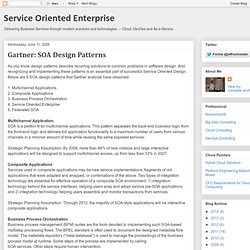
And recognizing and implementing these patterns is an essential part of successful Service Oriented Design. Below are 5 SOA design patterns that Gartner analysts have observed: 1. Multichannel Applications2. Composite Applications3. Multichannel ApplicationSOA is a perfect fit for multichannel applications. Strategic Planning Assumption: By 2008, more than 66% of new midsize and large interactive applications will be designed to support multichannel access, up from less than 33% in 2007.
Composite ApplicationsServices used in composite applications may be new service implementations, fragments of old applications that were adapted and wrapped, or combinations of the above. 10 SOA Commandments. Service Oriented Architecture (SOA) is an approach to organizing information processing.

It is capable of lowering the costs of information systems interoperability, by greatly reducing the number of aspects of these systems that have to be brought into agreement with each other for them to work together. If it can be successfully applied on a large scale, the systems landscape will differ from that of today in much the same way as today’s freight industry differs from that of the pre-container era.